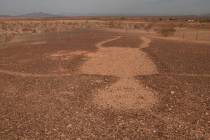Death Valley wonders are accessible to all
A day trip to Death Valley National Park, California makes a great excursion from Las Vegas for anyone, including those with limited mobility who use wheelchairs, scooters and other assistance devices. The Valley's most popular activities are about as doable for those using assistance equipment as they are for anybody else.
The weeks leading up to Christmas are the least crowded time to visit the park, yet offer pleasant daily high temperatures averaging 65 degrees. (Spring is the most popular season to visit because it offers the possibility of a good wildflower show. Summer there is unbearable to many, with everyday temperatures well exceeding 100 degrees.)
A good place to start a visit is the Furnace Creek Visitor Center, which is open daily from 8 a.m. to 5 p.m. Here you can pick up maps and books and ask park rangers for firsthand and up-to-date information.
Not to be skipped on any trip to Death Valley is a stop at Badwater Basin, which is about 17 miles south of the Furnace Creek Visitor Center. This is the lowest elevation in North America, 282 feet below sea level. This vast salt flat stretches about five miles to the base of the Panamint Range, where Telescope Peak rises to 11,049 feet above sea level. This is one of the few places you will ever see such a disparity in elevation.
From the parking area a 200-foot ramp leads down to a level wooden boardwalk, which takes you about 200 feet farther to the playa itself. From there most people with limited mobility can travel on the hardpan for approximately one-half mile, barring wet weather. The surface is so flat and hard that wheelchairs, scooters, canes and jogging strollers all work fine. But be aware that heavy rains can turn the salt pan into a shallow lake, so heading out onto it at such a time is ill-advised.
Those with limited mobility can access many of the park's other attractions. Just driving through the park you will see spectacular geologic formations including sand dunes, more salt pans and even palm oases. On your return from Badwater to Furnace Creek, be sure to take the nine-mile, one-way paved Artists Drive off of State Highway 178 (Badwater Drive). This is a great destination, yet only good for vehicles under 25 feet in length. Highlights include multi-hued, volcanic sediment hills, which are best seen in the late afternoon light.
Furnace Creek Ranch might be your next logical stop. The ranch offers visitors a general store and three restaurants, all wheelchair-accessible. The ranch has 224 guest rooms, including six that are accessible. The upscale Furnace Creek Inn, about one mile away, has 66 rooms but only has one accessible room. Reservations should be made well in advance for either of these properties if you plan an overnight stay. Call 800-236-7916 or visit furnacecreekresort.com.
Just a couple of miles north of the Furnace Creek Visitor Center is the Harmony Borax Works, which operated from 1883 to 1889. There is a paved 0.4-mile loop trail with a slight incline that takes you by the old refinery and the original wagons that were used to haul borax. Leaving here you can take an alternate gravel road north by some ruins and interesting geology 1.3 miles back to the main road through Mustard Canyon and back onto California 190.
Heading north from Harmony Borax Works on the main road, travel about 12 miles farther and go left onto the access road to Salt Creek Interpretative Trail. Follow this gravel road in for about one mile to the parking area and trailhead. Salt Creek is home to the Salt Creek pupfish, which are best seen in late winter to early spring. But it is a nice outing in winter as well, since it has not only a perennial creek but offers opportunities to view various birds. Here you will find a half-mile roundtrip, level boardwalk complete with resting benches. Please note that the boardwalk might not be suitable for mobility devices without wheels due to the spacing between its boards.
Deborah Wall is the author of "Base Camp Las Vegas: Hiking the Southwestern States" and "Great Hikes, A Cerca Country Guide," published by Stephens Press. Dennis Boulton is a retired Nevada teacher and geologist. They can be reached at Deborabus@aol.com.

















